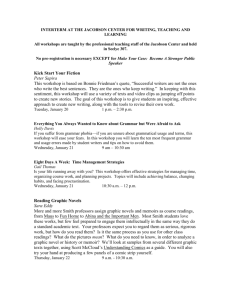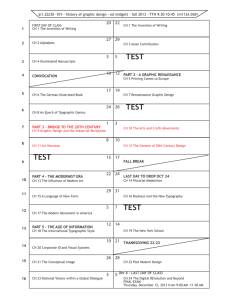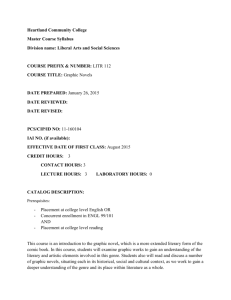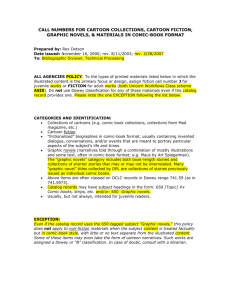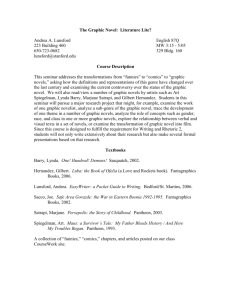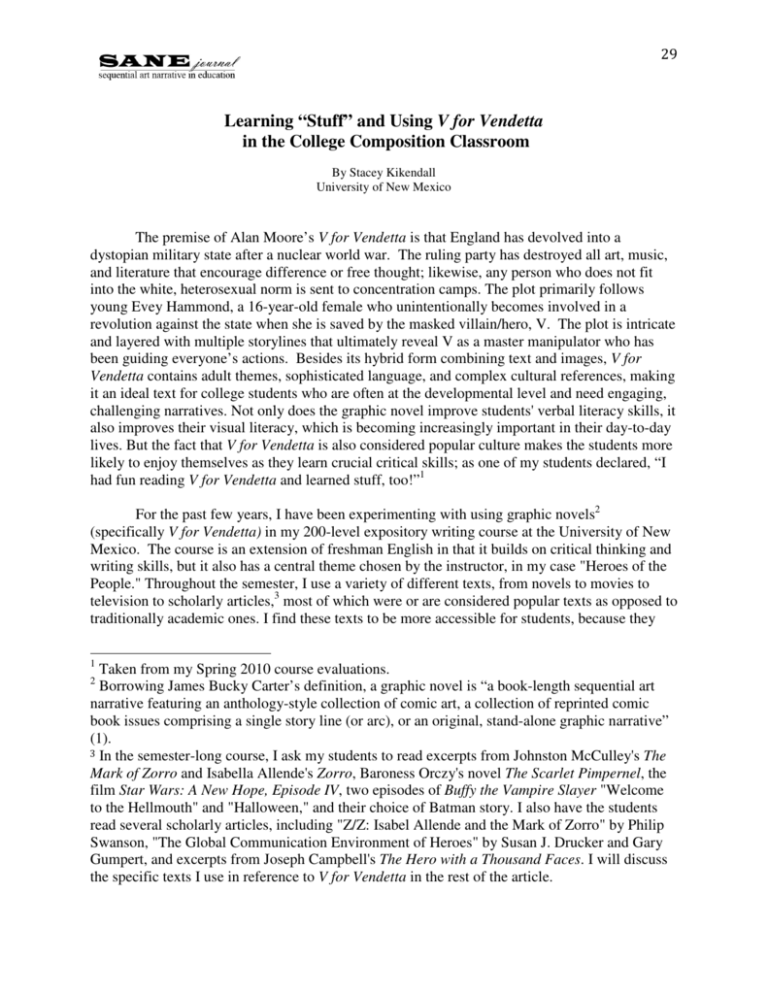
29
Learning “Stuff” and Using V for Vendetta
in the College Composition Classroom
By Stacey Kikendall
University of New Mexico
The premise of Alan Moore’s V for Vendetta is that England has devolved into a
dystopian military state after a nuclear world war. The ruling party has destroyed all art, music,
and literature that encourage difference or free thought; likewise, any person who does not fit
into the white, heterosexual norm is sent to concentration camps. The plot primarily follows
young Evey Hammond, a 16-year-old female who unintentionally becomes involved in a
revolution against the state when she is saved by the masked villain/hero, V. The plot is intricate
and layered with multiple storylines that ultimately reveal V as a master manipulator who has
been guiding everyone’s actions. Besides its hybrid form combining text and images, V for
Vendetta contains adult themes, sophisticated language, and complex cultural references, making
it an ideal text for college students who are often at the developmental level and need engaging,
challenging narratives. Not only does the graphic novel improve students' verbal literacy skills, it
also improves their visual literacy, which is becoming increasingly important in their day-to-day
lives. But the fact that V for Vendetta is also considered popular culture makes the students more
likely to enjoy themselves as they learn crucial critical skills; as one of my students declared, “I
had fun reading V for Vendetta and learned stuff, too!”1
For the past few years, I have been experimenting with using graphic novels2
(specifically V for Vendetta) in my 200-level expository writing course at the University of New
Mexico. The course is an extension of freshman English in that it builds on critical thinking and
writing skills, but it also has a central theme chosen by the instructor, in my case "Heroes of the
People." Throughout the semester, I use a variety of different texts, from novels to movies to
television to scholarly articles,3 most of which were or are considered popular texts as opposed to
traditionally academic ones. I find these texts to be more accessible for students, because they
1
Taken from my Spring 2010 course evaluations.
Borrowing James Bucky Carter’s definition, a graphic novel is “a book-length sequential art
narrative featuring an anthology-style collection of comic art, a collection of reprinted comic
book issues comprising a single story line (or arc), or an original, stand-alone graphic narrative”
(1).
3 In the semester-long course, I ask my students to read excerpts from Johnston McCulley's The
Mark of Zorro and Isabella Allende's Zorro, Baroness Orczy's novel The Scarlet Pimpernel, the
film Star Wars: A New Hope, Episode IV, two episodes of Buffy the Vampire Slayer "Welcome
to the Hellmouth" and "Halloween," and their choice of Batman story. I also have the students
read several scholarly articles, including "Z/Z: Isabel Allende and the Mark of Zorro" by Philip
Swanson, "The Global Communication Environment of Heroes" by Susan J. Drucker and Gary
Gumpert, and excerpts from Joseph Campbell's The Hero with a Thousand Faces. I will discuss
the specific texts I use in reference to V for Vendetta in the rest of the article.
2
30
usually are directly tapped into cultural ideologies that students can relate to, such as rebelling
against "the Man" or simply negotiating relationships. Moreover, popular culture creates
communities in which viewers/readers have a shared knowledge and language, and students
respond positively when they believe their opinions have authority and validity. The variety of
texts we examine also encourages students to expand their literacy skills. As the editors of
Teaching in the Pop Culture Zone explain, it is necessary to develop "these multiple literacies to
prepare students for the media-driven world in which we live, and they challenge us as teachers
to try new genres and technologies."
My class concludes with V for Vendetta, because it is a good way to combine the variety
of skills the students have learned in considering different genres and media. In addition, the
blurred line V straddles between hero and villain further complicates the definitions the class had
previously constructed. We analyze V for Vendetta as if it were any other literary text from our
class: we find themes, analyze characters, and examine the contextual elements (history, setting,
etc). While the graphic novel does not follow the form of a traditional novel, it still revolves
around a central narrative plot. The students' familiarity with this kind of analysis, which they
have been doing with varying degrees of complexity since middle school, gives us a way into the
text. In addition, of course, we explore the ways images are being used to complement or oppose
the written text. Images and words are no longer considered to be separate forms with no
interaction; as Charles A. Hill argues, "the boundary separating text from images has always
been little more than a convenient fiction, and as new computer technologies become more
sophisticated and more dominant, this fiction is becoming quite inconvenient" (127). In
encouraging my students to examine both the visual and written, I hope to expand their capacity
for rhetorical analysis.
As in most first-year writing programs at the college level, the students have specific
outcomes they need to achieve. At the University of New Mexico, we have the same three
outcomes for each of our introductory writing courses. The outcomes are “Finding and
Evaluating Information,” “Composing Documents,” and “Presenting Documents,” and they
become increasingly more complex as the student progresses through the classes. English 220:
Expository Writing is the third course in the sequence and presumes that the student has passed
English 101 and 102 or tested out of them. Thus, I expect the students to have encountered
different genres and writing situations, primary and secondary research, and have experience
with argument and analysis. However, I also expect students to struggle with more complex
incarnations of genre and analysis. As 220 is often the last English course students will take in
their college career, I also feel pressure to prepare them to use their newfound critical thinking
and writing skills in less obvious situations and contexts.
For my particular section of English 220, students improve these skills by focusing on the
general topic of “Heroes of the People”, which include Zorro, the Scarlet Pimpernel, V and
Evey, Luke Skywalker, Batman, and Buffy. The topic, texts, and themes discussed in the course
should find echoes in most students as, regardless of our age, race, gender, or nationality, we all
have ideas of what a hero should or shouldn’t be. In using a variety of textual formats, the
students learn to use and adapt their critical skills in different circumstances. By focusing on
“Heroes of the People” for the main topic of the class, I am able to address a variety of
interesting themes such as hidden identities, heroism vs. criminality, revolution, governmental
31
control, nationalism, race, class, and gender. In addition to their popular appeal, these stories
reveal interesting historical and cultural beliefs that are still relevant today as well as the changes
in technology. Students start to make connections with their own lives and the modern political
and social context. I believe in giving the students the critical tools they need and showing them
how they can be used in different circumstances, from academic closed-form writing to film
reviews to presentations. In doing this, I help them to realize that no matter the topic or the class
they can be more critical thinkers and writers. All of their writing assignments address aspects
of the 220 outcomes, but the larger projects ask them to use all outcomes – thus demonstrating
that writing is a process.
In this essay, I would like to discuss the various ways I use V for Vendetta in my course
and my students’ reactions, which are usually overwhelmingly positive. Moreover, I would like
to explore the ways in which we as college instructors can develop courses that include
uncommon literary texts to still achieve our teaching goals of improving students’ reading
comprehension, analytical thinking, and writing skills.
INTRODUCING STUDENTS TO A NEW MEDIUM
In their previous assigned readings, my students learn to respond to traditional literary
texts such as novels and other media such as films, television episodes, scholarly journal articles,
and popular magazine essays, but most have never encountered a graphic novel (with a few
exceptions). As a result, I need to spend some time introducing them to the medium and
appropriate reading strategies; however, as this is a composition course and not one on comics or
graphic novels, I have to keep my discussion fairly basic. I usually use an essay by Charles
McGrath entitled “Not Funnies” from the Longman writing textbook, Beyond Words.4 The essay
does a good job of giving some background information about the history of graphic novels and
how they are structured/created, how graphic novelists view themselves and their work,
including a bit about Alan Moore, and example pages from famous graphic novels such as Ghost
World and Pages. At the same time, the essay ends with a somewhat condescending and, I think,
somewhat inaccurate summation of the form, which McGrath refers to as a genre. McGrath
states,
The genre’s greatest strength and greatest weakness is that no matter how far the graphic
novel verges toward realism, its basic idiom is always a little, well cartoonish. Sacco’s
example notwithstanding, this is a medium probably not well suited to lyricism or strong
emotion, and (again, Sacco excepted) the very best graphic novels don’t take themselves
entirely seriously. They appeal to that childish part of ourselves that delights in
caricature, and they rely on the magic, familiar but always a little startling, that reliably
turns some lines, dots and squiggles into a face or a figure. (313)
I ask my students to think about this idea and do a quick survey of whether they agree or
disagree with McGrath’s statement. Most of the time, the students are inclined to agree with
him, although they are unwilling to put too much stake into their answers as they have no firsthand experience with graphic novels. I return to this quote at the end of the unit, and the
students now overwhelmingly disagree with him and want to argue about the complexities of
emotion and language and art in a text such as V.
4
The essay was originally published in the New York Times Magazine in 2004.
32
The first day we start discussing the text, I have the class look at the very first page of the
story, included as Appendix 1. I always begin here with my students because it reveals not only
the connection between text and image but also how each in its own right is incredibly detailed
and significant to setting up the story. Moreover, the simple act of seeing a page of a graphic
novel, which many of the students have no experience with, gives the students a chance to
familiarize themselves with the form in a low-stakes environment. Rocco Versaci outlines a
similar activity in his article, "Literary Literacy," in which he explains, "any given comic book
panel contains a variety of information that must be processed, and the 'static' format allows a
teacher to spend time focusing on analytical skills" (96). I agree that the focused attention we can
give to the first page allows me to extract very detailed responses from my students. While
Versaci focuses on one panel, I like to have my students look at the entire page, because it alerts
them to the larger and interrelated context of each individual panel. For example, from the text,
we learn the date (November 5, 1997), the fact that weather can be minutely predicted, the
setting (London), and the fact that some areas are quarantined, food is being rationed, and
terrorists are sent to detention centers.
From the images, we see Big Brother-esque cameras and surveillance equipment
claiming “For your protection,” checkpoints and police, and the introduction of two important
characters, Evey and V. I ask the students to identify details in the last few frames that tell us
something about these two characters, and after a stumbling start they pull out examples. They
see Evey at a mirror putting on lipstick, which is usually a habit of adult women, but then they
see the contrast of the stuffed teddy bear on her bed, which implies she is still a child. Then the
students see the scene mirrored, literally, in the frame with V approaching his own vanity mirror.
They point out the movie posters on the wall and different pieces of his costume waiting to be
donned, revealing V’s theatrical personality. They also talk about V’s interest in the structure of
society, demonstrated by the variety of books on his shelf, including Thomas More’s Utopia,
Karl Marx’s Capital, and Adolf Hitler’s Mein Kampf. In addition, there is a shadow of a lion’s
head in the upper right corner of the frame, which one student very acutely (if tentatively)
identified as the stone lion from London’s Trafalgar Square – representing another one of V’s
attempts to preserve history and culture.
This examination of the first page is a scaffolding exercise I do with my class in which I
can help to prepare them for reading the graphic novel in the detail that it deserves.5 I continue
to point out details they might have missed throughout the following weeks. For example, in one
scene there is a Les Miserables poster in the background, and I point out the obvious connections
that our story has to the French Revolution. This is particularly relevant to my class, because we
talk extensively about the French Revolution when we read The Scarlet Pimpernel early in the
semester. But this detail-oriented exercise also serves to warn the students that reading may take
longer than they anticipate. V is fairly long and because of its unfamiliarity, we spend three
weeks discussing it. The book itself makes this easy to do by being divided into three separate
sections.
5
The idea that I can help students negotiate the gap between the skills they've learned
previously and applying it to a particular text is based on Lev Vygotsky's theory of the zone
of proximal development.
33
After giving the students a bit of background, we go over the nature of the comics
medium itself – the intricate combination of text and image. As Nancy Allen explains, both
words and images work "in a different but often collaborative way to make a contribution to our
overall making of meaning" (17). We review the strategies we had used with previous texts for
reading and watching. For example, we talk about analyzing language in the sense of diction or
word choice, tone or voice, style, description, dialogue, punctuation, meanings and double
meanings, connotations, etc. Then we talk about analyzing visual images in the sense of color,
contrast, point of view, angle of vision, backgrounds and foregrounds, and focal points.6 Then
we brainstorm about how we can combine these two strategies to account for the hybrid genre of
graphic novels.
Often, without any prompting from me, students are able to articulate the moments where
words and images represent two different meanings and the contradiction provides a third, more
subtle meaning. For example, the students immediately recognize the irony on page 2, wherein
the picture shows Evey dressed as a prostitute while the written text claims "that is the face of
London tonight." In addition, I usually give them some tips for reading, including taking notes,
reading and looking at the images sequentially and simultaneously,7 paying attention to the
appearance of the written text, looking at the panels like a film, and examining the overall layout
of the two-page spread. See Appendix 2 for the handout where I explain these moves in more
detail.
ASSIGNMENTS AND ACTIVITIES
As our discussion of V progresses, I have the students participate in a variety of in-class
activities and written homework assignments that push them to strengthen their critical thinking
and writing skills. Moreover, I find that collaborative learning can challenge students to embrace
the problems and benefits of working with others; or, as John Bean describes it, "collaborative
learning promote[s] argumentation and consensus building" wherein in I create "an environment
of productive talk that leads to greatly enriched inquiry, analysis, and argument" (150). Once
during the semester, each student takes part in a group presentation in which they join three of
their classmates to give a 15-25 minute group presentation about a text. Each student chooses an
individual angle or topic to focus on, but overall the presentation should have some sort of
coherence and minimal repetition. Some of the potential topics they can choose from include:
•
•
6
What is the Historical/Social Context? – In what time period does the story occur? What
is important about that time? How does it relate to the story?
What other versions of the story are there? How do they differ? What might these
differences mean?
These points of analysis for written texts and visual texts are taken from traditional
modes of analyzing literature and photography.
7
Lynell Burmark says in her essay on “Visual Literacy,” words are sequential while images are
simultaneous, “Words by their very nature are sequential, like a string of letters typed on a
keyboard. Images, on the other hand, are simultaneous – everyone becomes part of the picture at
the same time” (8). In reading graphic novels, the students have to utilize both.
34
•
•
•
•
•
•
•
•
In what time period was this particular version of the story published or produced? Does
that make a difference? Do you think you see the story differently than its original
audience would have? Why?
What are some of the major themes in the story? (Class/Gender/Tyranny/etc) Give
examples from the text and explain their significance.
What can we determine about the characters? Give a detailed character analysis of one or
two characters using examples from the text.
What do we know about the author of the text? Does this knowledge help our
understanding of the text? How and why?
What form is the text in? (Movie / Novel / Graphic Novel) How does that change or
influence the telling of the story?
If it is a movie, how do the sound and visual aspects affect our understanding of the
story? If it is a novel, what stylistic elements do you notice?
(Repetition/Metaphor/Dialogue/etc)
What stood out to you in the story? Why? Do a close reading of a specific scene or an
important word or phrase.
What do scholars have to say about this story? Do you agree with them? Why or why
not?
Most groups use PowerPoint or some sort of multimedia to make the presentation more
engaging, such as movie clips, songs, and pictures along with their text. They create a handout
for the class and end with 3-4 discussion questions that revolve around what they have presented.
It is a writing class, so they turn in an essay version of their presentation as well. I usually have
the groups present at the beginning of the sequences, so I don’t inadvertently cover material in
their presentations. V for Vendetta allows for a variety of contexts the students can explore,
including when and where the novel was written (1980s England); or historical references such
as Guy Fawkes, fascism, or the threat of Nuclear War; or the setting and background of the story
- London 1997 – the future, where there was a recession in the 1980s, then nuclear war (Russia
and Poland) resulting in Africa and Europe being wiped out, weather problems (floods, no food),
riots and violence, no controlling government just gangs, fascists take power (and get rid of
“Others”); or any number of themes including civil rights, governmental tyranny,
rebellion/revolution, racism and xenophobia, sexism, homophobia, theatricality and
performance, surveillance and protection, torture, vigilantism, scientific experimentation and
ethics, religion/religious institutions and pedophilia, villainy and heroism, anarchy (as both
destructive and creative), and freedom; or character or genre analysis; or current scholarship on
V or graphic novels.
After we get into the novel and start discussing it in class, I often have the students
answer some initial questions in writing to get the critical juices flowing, in addition to having
them practice putting their ideas into writing. I ask questions such as: What similarities do you
see between V and the Leader? What is the purpose of V’s broadcast? How and in what way is
Evey transformed? What do people do when no one is looking/listening (both generally and
specifically in V)? How will the country fill the silence? How are women portrayed in the book?
Some of these questions aim directly at reading comprehension, but others ask for more complex
analysis and comparisons.
35
One of the group activities I have the students do is pick a particular scene they think is
interesting and/or important, and then look closely and analyze one frame/panel/page for how the
visual and text work together or contrast, and what details or gaps are revealed. This is very
similar to activity I used to introduce the graphic novel, so the students already have some points
of reference. Moreover, as Rocco Versaci says, by allowing students to choose their own scene
to analyze, it "helps them to see themselves as active, interpretive readers" (97). The students
then share their interpretation with the class, who respond with comments of their own. I also
usually show a clip from the film adaptation of the novel to have them analyze another medium
and discuss how it changes the meaning and what can or can’t be done in particular genres or
mediums. James Reynolds has a good essay on the comic-to-film adaptation of V, which I make
available to the students via the university’s online teaching tool (i.e. Blackboard).8
During each sequence, the students have to write several shorter writing assignments of
approximately two pages. Some of the prompts I give them include:
•
•
Analyze how V problematizes the dichotomy of hero/villain using at least two
specific examples from the book.
Throughout the semester, we have been making allusions to the similarities between
some of the themes in the texts and current times. How do you relate the events and
themes in V for Vendetta to modern life in America? Use specific examples from
both V and life.
The latter question I always frame by having the students read a couple essays from a Longman
topics reader titled Citizenship Now, including “Security versus Civil Liberties” by Richard
Posner and “Protecting Dr. King’s Legacy: Justice and Liberty in the Wake of September 11th”
by Nadine Strossen. In both essays, the authors question whether issues of national security
should take priority over civil liberties in the climate of our past and current “war on terrorism.” I
have the students compare the two positions and then discuss their own ideas. Then I guide them
into a discussion of how these issues are portrayed in V.
Beyond connections to September 11th, V also offers a platform from which students can
discuss a variety of current social and political issues.9 The recent revolution in Egypt and the
uprisings in the Middle East offer ideal real world connections to the novel and the question of
whether anarchy is ever necessary. Similarly, recent high profile discussions of same-sex
8
Students always find it interesting that Moore, who had stated that comics could stand on their
own as an art form with ‘the weight, depth, and moment of our stories’, rejected the film
adaptation of V (Reynolds 126, 130).
9
Tony Williams’s liberal-leaning article “Assessing V for Vendetta” points out many of the
political issues the story reveals: “V for Vendetta’s England with its gay-bashing, spin doctoring
news manipulation, Guantanamo Bay type concentration camps, and brutal authoritarian control
really represents a dystopian version of contemporary America which is now continuing the
legacy of Nazi Germany with suspension of civil liberties for suspected ‘terrorists’, illegal
confinement, government surveillance in defiance of its Constitution, torture, humiliation, and
murder of prisoners aided by the complicity of an apathetic population who are the twenty-first
century’s equivalent of Hitler’s ‘willing executioners’” (18).
36
marriage and the bullying of gay teens relate to underlying prejudices held by the fascist
government in V. Even the ongoing attack on education, teachers, and the arts offer links to the
ways in which V claims the government eradicated culture.
An activity that I have recently envisioned for the class is incorporating a current story
from The Chronicle of Higher Education. Last fall at Washington State University, a student
hacked into the university’s media system and broadcast a video message reminiscent of V’s in V
for Vendetta. The student wore V’s Guy Fawkes costume and even attempted to mimic his
language while making a metaphorical argument about the students at the university.10 I think
that my students would benefit from watching this video message and analyzing the rhetoric
used, such as the way he relies on the ethos of V as representative of necessary anarchy and
criticism of the government and status quo. In addition, the appropriation of Guy Fawkes masks
by some of the Occupy Wallstreet protesters is another contemporary example the students could
examine.
STUDENT REACTIONS
I don’t expect all of my students to become avid readers of graphic novels (although
some do), but I do hope that they learn to appreciate how complex and engaging some kinds of
popular culture can be.11 I want them to continue to enjoy their movies and bestsellers, but I also
want to prevent them from being passive receivers of information. I want them to be able to see
popular culture (like graphic novels) as something that can be analyzed and ultimately reveal
various ideological stances. As a short writing assignment, I have them write a letter to the
editor of a local newspaper arguing for or against using graphic novels in the classroom; they can
choose whether it is a high school or college classroom. In his essay “Seven Ways I Don’t
Teach Comics,” Joseph Witek declares, “I don’t ever apologize for comics” as number three.
While I definitely do not apologize for using V for Vendetta or other texts considered popular
culture, I do ask my students to consider why I would choose such a text and to consider why it
is worthy of literary consideration. I ask them to think about it as a medium just like the others
we examined. The last time I taught the course, every one of my students made an argument for
using graphic novels in classrooms. Obviously, some of the students might have just been
saying what they thought I wanted to hear (despite my assurance otherwise). However, my end
of the semester course evaluations revealed that they really did enjoy the unit and learned from it
(consistently over 80%), and for many it was their favorite text (usually over 50%). I have
included below excerpts from sample letters two of my students wrote:
Graphic novels often times have very deep and intellectual meanings and educate the
reader in history, philosophy, sociology, psychology, and even literature and poetry.
Although I am not questioning the educational value of classic literature, I do believe that
we are at a point and time in our society where modern, perhaps more appealing, forms of
10
He overtly discusses squirrels on campus, but clearly he is using this as a metaphor for student
apathy.
11
Usually by the end of our discussion about V, many students want to revise either their
definition of “popular culture” or whether graphic novels should be considered popular culture
with its connotations of “low art.”
37
literature should be tied into schools curriculums… The main character is based upon the
British historical figure of Guy Fawkes, who tried to blow up the parliament. Inspired by
Fawkes, V sets the Parliament ablaze on the same exact date, November 5th. Also, the
concentration camps, and entire conflict between government and populous can be traced
back to the fascist Nazi regime, upon which Norsefire is based. Simply by knowing these
facts it becomes apparent how history, political conflict, and sociological ideas play a
dominant role in the graphic novel. Also, nearly all characters undergo a psychological
transformation, like Evey Hammond: from uneducated teenager to a legacy-carrying
symbol of justice and freedom. V psychologically breaks down Evey in order to rebuild
her. Furthermore, V is one of the most articulate and intelligent characters I have ever
encountered.12 (Student 1)
As the term suggests, graphic novels are novels presented in the form of dialogues,
narrative, and illustrated visuals; they present an order to the story with developments in
plots and characters like traditional novels. Though Americans tend to think that graphic
novels are merely simplistic comics with no educational value, Europeans and the
Japanese honor the genre as being more than entertainment. In addition, a comic is
textually and visually distinct from a graphic novels in the complexity of the form;
graphic novels require sophisticated reading as graphic novels work elaborately as a
whole with every detail intentionally placed for scholastic interpretation (NCTE).
(Student 2)
What I want to point out in the letters is that (whether or not it was in fact their personal opinion)
they recognized (with varying degrees of sophistication) what graphic novels, particularly V for
Vendetta, have to offer. The students mention history, philosophy, psychology, language,
illustrations, and the increasing legitimization of graphic novels by institutions. I really could
not ask for more since they obviously see how and why I am using this particular text (which
may not initially seem very academic) to fulfill our course goals and make them more critical
writers and thinkers.
CONCLUSIONS
Nancy Frey and Douglas Fisher ask in the introduction to their edited volume, Teaching
Visual Literacy, “Do comic books and graphic novels constitute an appropriate genre for
classroom instruction?” (2). As the purpose of their book, Frey and Fisher obviously answer this
question in the affirmative. However, for my composition classroom and the administrators of
the program, the answer is not so obvious. Yet when I point out that “as with reading
comprehension, visually literate learners are able to make connections, determine importance,
synthesize information, evaluate, and critique. Further, these visual literacies are interwoven with
textual ones, so that their interaction forms the basis for a more complete understanding” (Frey
and Fisher 1), I can easily make connections between graphic novels and the English department
outcomes for my course. In addition, our students are constantly being bombarded with visual
images, from billboards to movies to the Internet, and I want to prevent them passively accepting
12
All misspellings and grammatical problems are the students’; I have copied their language
verbatim. Permission granted by students for use of letters.
38
everything they encounter. As Catherine L. Hobbs argues, "to condone and contribute to visual
illiteracy contradicts our purpose of teaching effective and ethical written communication" (55).
Students need to learn to critically interpret and respond to the variety of written, visual, and
hybrid texts they encounter every day not just the "academic" texts we provide for them. In fact,
Rocco Versaci claims that the "densely packed" Internet sites our students go to for information,
"ask readers to move their eyes diagonally and up and down in addition to side to side - the same
kind of movements that come with reading comic book panels and pages" (97).
For some, it might seem unusual to have students use popular culture (such as movies and
graphic novels) in a writing class, but by connecting the rhetorical strategies I and the UNM
English Department want them to learn with things they experience and enjoy in their everyday
life (such as visual images and dramatic story telling), I make the skills more real and more
useful to them. So while I hope that my students have fun, it is not, of course, my primary goal. I
strongly believe that if they start to see how critical thinking and writing skills can be used
beyond traditional academic papers, they will be more likely to see their usefulness in other
situations and contexts. As graphic narratives gain more and more traction as a useful tool for
teaching different forms of literacy, I hope to continue encouraging my students to search below
the surface in order to reach the complexities of V for Vendetta. Or, as my student so succinctly
put it, I hope to help them to continue to “learn stuff!”
39
Works Cited
Allen, Nancy. "Relationships Between Words and Images: An Overview." Working with Words
and Images: New Steps in an Old Dance. Ed. Nancy Allen. Westport: Ablex, 2002. Print.
Bean, John C. Engaging Ideas: The Professor's Guide to Integrating Writing, Critical Thinking,
and Active Learning in the Classroom. San Francisco: Jossey-Bass, 2001. Print.
Burmark, Lynell. “Visual Literacy: What You Get Is What You See.” Teaching Visual Literacy:
Using Comic Books, Graphic Novels, Anime, Cartoons, and More to Develop
Comprehension and Thinking Skills. Ed. Nancy Frey and Douglas Fisher. Thousand
Oaks: Corwin Press, 2008. 5-26. Print.
Carter, James Bucky. Building Literacy Connections with Graphic Novels. Urbana: NCTE, 2007.
Print.
Frey, Nancy and Douglas Fisher. “Introduction.” Teaching Visual Literacy: Using Comic Books,
Graphic Novels, Anime, Cartoons, and More to Develop Comprehension and Thinking
Skills. Ed. Nancy Frey and Douglas Fisher. Thousand Oaks: Corwin Press, 2008. 1-4.
Print.
Friedman, Michael D. “Shakespeare and the Catholic Revenger: V for Vendetta.” Literature Film
Quarterly 38.2 (2010): 117-133. Print.
Hill, Charles A. "Reading the Visual in College Writing Classes." Visual Rhetoric in a Digital
World: A Critical Sourcebook. Boston: Bedford/St. Martin's, 2004. 107-130. Print.
Hobbs, Catherine L. "Learning from the Past: Verbal and Visual Literacy in Early Modern
Rhetoric and Writing Pedagogy." Visual Rhetoric in a Digital World: A Critical
Sourcebook. Boston: Bedford/St. Martin's, 2004. 55-70. Print.
Moore, Alan and David Lloyd. V for Vendetta. New York: DC Comics, 1988. Print.
"Preface." Teaching in the Pop Culture Zone: Using Popular Culture in the Composition
Classroom. Ed. Allison D. Smith, Trixie G. Smith, Rebecca Bobbitt. Boston: Wadsworth,
2009. Print.
“Using Comics and Graphic Novels in the Classroom.” The Council Chronicle NCTE.org.
National Council of Teachers of English. 5 September Web. 13 April 2010.
Versaci, Rocco. "'Literary Literacy' and the Role of the Comic Book; Or, 'You Teach a Class on
What?" Teaching Visual Literacy: Using Comic Books, Graphic Novels, Anime,
Cartoons, and More to Develop Comprehension and Thinking Skills. Ed. Nancy Frey and
Douglas Fisher. Thousand Oaks: Corwin Press, 2008. 91-111. Print.
Williams, Tony. “Assessing V for Vendetta.” Cineaction 70 (2006): 17-23. Print.
40
Witek, Joseph. “Seven Ways I Don’t Teach Comics.” Teaching the Graphic Novel. Ed. Stephen
E. Tabachnick. New York: MLA, 2009. 217-222. Print.
Works Used in V for Vendetta Unit
Ford, John and Marjorie Ford. Citizenship Now. New York: Pearson Longman, 2004. Print.
Kaya, Travis. “Hacker Makes the 5th of November One to Remember.” The Chronicle of Higher
Education. 8 November 2010. Web. 27 January 2011.
McGrath, Charles. “Not Funnies.” Beyond Words: Reading and Writing in a Visual Age. Ed.
John Ruszkiewicz, Daniel Anderson, and Christy Friend. New York: Pearson Longman,
2006. 294-313. Print.
Moore, Alan and David Lloyd. V for Vendetta. New York: DC Comics, 1988. Print.
Reynolds, James. “‘Kill Me Sentiment’: V for Vendetta and comic-to-film adaptation.” Journal
of Adaptation in Film & Performance 2.2 (2009): 121-136. Print.
41
Appendix1
42
Appendix 2
Tips for Reading V for Vendetta
Our next unit involves a medium many of you are probably unfamiliar with - the graphic novel.
I've included below some tips for reading, many of which are repeats from previous texts but
several that are specific to graphic novels.
•
Take notes
Just as you have done for previous texts, take notes in the book itself and/or in your
notebook. Mark (highlight/underline) places in the text that you think are important, that
you don't understand, or that evoke some kind of emotional response from you. For
example, I might put a smiley face next to a line or scene I find funny, or I might write a
brief note to myself about a scene that relates to a theme I've seen elsewhere in the text or
even in other texts we've read. With a longer text, it is often difficult to remember exactly
what you read the night before, so taking notes is crucial.
•
Read and look at the images sequentially and simultaneously
Words require sequential reading. For example, you read left to right in order, one word
after the other. In contrast, images are usually read simultaneously. For instance, you take
in everything in an image at once. You will need to do both with a graphic novel. (Lynell
Burmark "Visual Literacy" 8)
•
Pay attention to the appearance of the written text
Written text can sometimes indicate motion or sound or feeling. For example, a bubble
containing the word "NOOOOOOOOOO" (page 35 in V) obviously suggests a long,
drawn out yell or moan. The fact that the word contains nine extra O's emphasizes the
strong feeling.
•
Look at the panels like a film
As we did when watching Star Wars or Buffy, consider where the director places the
camera. In other words, how is the scene framed and what is the focal point. Are we
looking up, down, from a distance, close-up, or from behind? For example, in the same
frame mentioned above on page 35, we see an extreme close-up of Lewis Prothero, in
which he is sweating and his eyes and mouth are open wide. This image, just as the
written text does, suggests extreme personal emotion.
•
Examine the overall layout of the two-page spread
Look at each frame, then the panel, then the entire page and two-page spread, noting the
contrast or blending of panels. We will practice this in class, but think about things such
as the size of the frames, how many there are in each row, whether the frames show the
same setting or jump to a different setting, the similarity or difference in color choices,
and whether they indicate movement.




